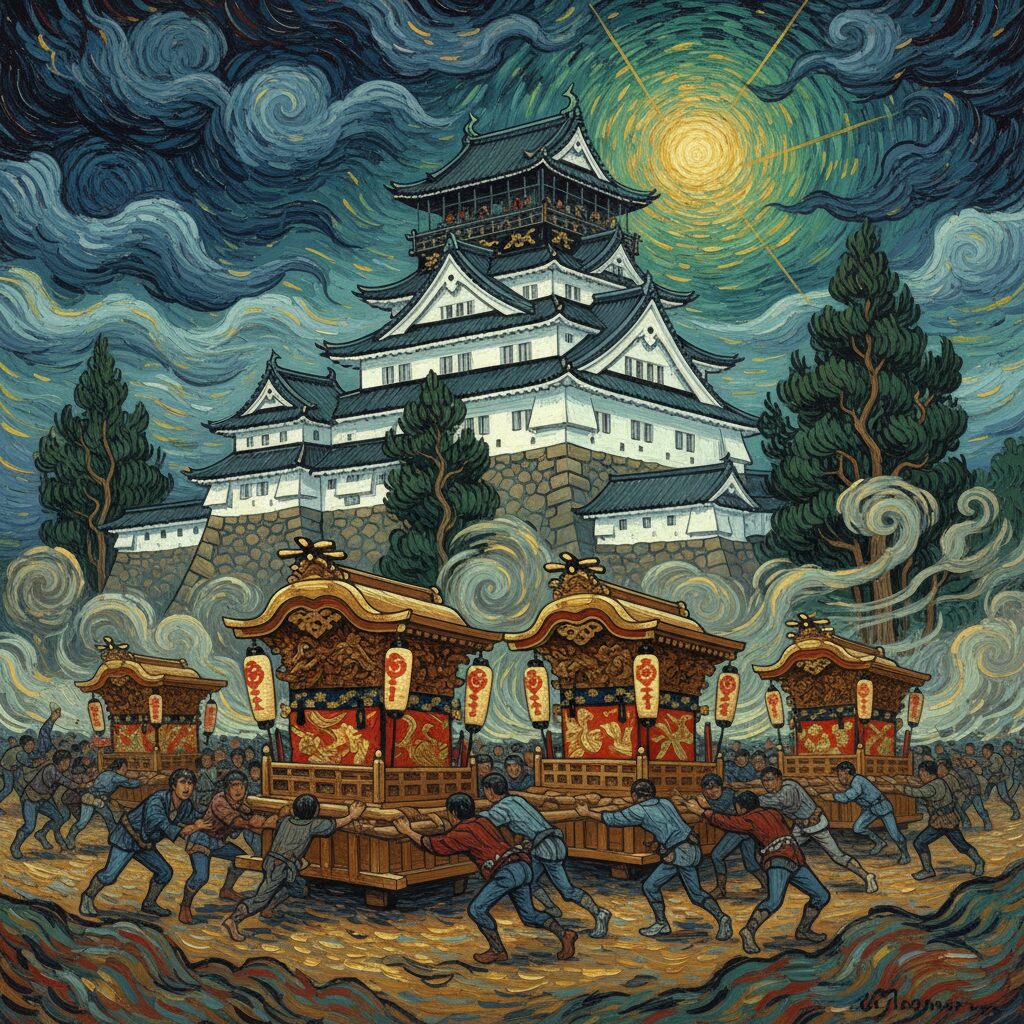When the mind conjures images of Osaka’s samurai past, it invariably summons the colossal stone walls and the magnificent, five-storied keep of Osaka Castle, a titan of Japanese history that dominates the city’s skyline. It is a story of grand unifiers, of epic sieges, and of a power that shaped the nation. Yet, the narrative of warrior culture in this region does not end at the imposing moats of that great fortress. To truly understand the soul of this land, one must venture beyond the city’s bustling heart, following the coastline south, where a different kind of history breathes. Here, in the city of Kishiwada, stands a castle not of overwhelming scale, but of profound local significance and fierce pride. Kishiwada Castle, a graceful structure nicknamed the Phoenix Castle, offers a more intimate, yet equally compelling, saga of feudal lords, strategic battles, and a cultural legacy that thunders through the streets to this very day in the form of the exhilarating Danjiri Matsuri. This is a journey into the heart of a community forged by its castle, a place where the spirit of the samurai lives on not just in museum exhibits, but in the vibrant, thrumming soul of its people. It is a testament to the idea that history’s most powerful stories are often found just a short train ride away from the well-trodden path.
The Journey South: A Different Osaka Story

The adventure to Kishiwada begins not with a grand parade, but with the steady clatter of a Nankai Main Line train departing from the cavernous Namba Station. As the train moves away from the city’s dense urban center, the scenery undergoes a subtle yet notable transformation. Towering skyscrapers give way to an expansive mosaic of residential neighborhoods, small factories, and local shrines, their tiled roofs peeking out between modern buildings. There is a strong sense of leaving the international metropolis behind and entering a more grounded, distinctly Japanese area. The air itself seems to shift as the train approaches the coast; a faint, salty breeze hints at the nearby Osaka Bay. This is not the polished, curated experience of a major tourist destination. Rather, it is a journey into the daily life of the Senshu region, the southern part of Osaka Prefecture. Stepping off the train at Kishiwada Station, one is welcomed not by throngs of tourists, but by the gentle buzz of a thriving local city. The streets are clean, the atmosphere calm. The castle is not immediately visible, adding a sense of discovery to the short walk from the station through quiet streets toward the historic heart of the town. This gradual approach heightens anticipation, allowing the ambiance of the castle town, or jokamachi, to slowly surround you before its central landmark appears.
First Glimpse: The Phoenix Castle Rises
Then, it emerges. Kishiwada Castle towers above the surrounding trees and buildings, a vision of white plaster walls and graceful, layered roofs topped with dark grey tiles. Though undeniably smaller than its renowned counterpart in central Osaka, it exudes a distinct, refined dignity. The present three-tiered, five-story keep, or tenshu, is a faithful 1954 reconstruction, replacing the previous structure that was sadly destroyed by lightning in 1827. Still, it rests on the original, imposing stone foundations, a symbol of the fortress’s enduring presence through centuries of change. The castle is fondly called Chikiri Castle, a name inspired by the castle grounds’ shape, which from above resembled a chikiri, a wooden spool used in the local textile weaving industry. This modest, industrial nickname reveals much about the castle’s deep connection to the community it protected. It served not only as a military stronghold but also as the heart of a working town. The surrounding moat, wide and tranquil, mirrors the sky and the formidable stone walls, or ishigaki, that rise from its waters. These stones, fitted with expert precision, are the genuine remains of the original fortress. Crossing the bridge and passing through the gate, you sense a strong link to the past, stepping onto ground once walked by samurai retainers, feudal lords, and the townspeople who relied on their protection.
A Tapestry of Warlords and Shoguns: The History Within the Walls

To appreciate Kishiwada Castle is to explore a rich and intricate history that reflects the wider story of Japan’s feudal era. Rather than being dominated by a single clan, its history is shaped by a succession of lords who influenced its fate in response to the ever-changing power dynamics.
The Early Days and Strategic Importance
The site’s origins as a fortress date back to the 14th century, during the chaotic Nanboku-chō period when rival imperial courts competed for dominance. A warrior named Wada Takahie of the Kusunoki clan is credited with constructing the initial fortification here. Its strategic significance was clear from the start. Located in Izumi Province, it controlled a crucial coastal route—the Kishu Kaidō—which linked the economically vital Settsu Province (present-day Osaka) with the spiritually important Kii Province (present-day Wakayama). Controlling Kishiwada meant controlling the movement of goods, armies, and information along this essential southern corridor. For centuries, the castle remained a coveted strategic asset, frequently changing hands among local clans vying for regional control.
The Tumultuous Sengoku Period
Kishiwada Castle’s prominence surged during the 16th century Sengoku period, also known as the Age of Warring States. As Oda Nobunaga sought to unify the country, Kishiwada became a key target in his campaign to dominate Izumi. After a series of intense battles, the castle was seized by Nobunaga’s forces. Recognizing its strategic value, he placed it under the command of his trusted generals. Following Nobunaga’s assassination, his successor Toyotomi Hideyoshi continued to value the castle highly. In 1585, he appointed his vassal Koide Hidemasa as lord of Kishiwada. Under Hidemasa, the castle underwent significant expansion and modernization, including the construction of an impressive five-story main keep and the development of the surrounding castle town. This era saw Kishiwada’s evolution from a simple fortress into a major feudal domain center.
The Edo Period and the Enduring Okabe Clan
With the early 17th-century establishment of the Tokugawa Shogunate, Japan entered a prolonged period of relative peace. The constant warfare era ended, and castles transitioned from purely military bases to administrative and political hubs. In 1640, a major shift occurred when Okabe Nobukatsu was transferred from another domain to become lord of Kishiwada. This began a remarkable era of stability, as the Okabe clan would govern the castle for thirteen generations, lasting until the Meiji Restoration in 1868. The Okabe lords improved both the castle and its town, promoted local industries, and supported cultural development. Their long and continuous rule constitutes the defining chapter of Kishiwada Castle’s history, and their legacy remains deeply embedded within the castle’s walls and the town’s traditions today. It was under their leadership that the peaceful and prosperous environment emerged, ultimately giving rise to the town’s most celebrated cultural event: the Danjiri Matsuri.
Inside the Keep: A Vertical Journey Through Time
Entering the reconstructed keep is like stepping into a vertical museum. Each floor provides a unique glimpse into the castle’s history and the lives of its former inhabitants. The ascent up the steep wooden staircases—a defensive design in itself—is an experience that physically connects you to the structure’s original function. The lower floors focus on the history of Kishiwada and the Okabe clan. The carefully curated exhibits display a wealth of historical artifacts. You can admire menacing suits of samurai armor, their lacquered plates and silk cords still exuding an aura of power. Razor-sharp katanas and polearms, the weapons of the warrior class, are shown alongside detailed maps of the domain and official documents marked with the vermilion seals of the lords. These exhibits are more than relics; they are tangible links to the governance, conflicts, and daily administration of a feudal domain. As you climb higher, the emphasis shifts to the cultural life of Kishiwada, featuring displays related to local arts, crafts, and, naturally, the Danjiri Matsuri. The journey culminates on the top floor. Stepping onto the observation balcony, you are rewarded with a stunning panoramic view. To the west, the vast expanse of Osaka Bay sparkles under the sun, with ships heading toward the distant ports of Kobe and Awaji Island. To the east, the city of Kishiwada spreads out below, blending traditional tiled roofs with modern buildings, extending toward the green slopes of the Kongo and Izumi Katsuragi mountain ranges. From this vantage point, you can fully appreciate the strategic brilliance of the castle’s location and sense the presence of the lords who once overlooked their domain from this very spot.
The Soul of Kishiwada: The Danjiri Matsuri Connection

No account of Kishiwada Castle is complete without delving into its deep and inseparable connection with the Kishiwada Danjiri Matsuri, one of Japan’s most exhilarating and perilous festivals. The castle serves not just as a backdrop for this event but stands as its historical and spiritual birthplace.
The Legend of Inaba Masanori
The festival’s origins trace back to a notable act by an Okabe lord in 1703. Lord Okabe Nagayasu (known at the time by his pre-lordship name Inaba Masanori) established a Fushimi Inari Shrine within the castle’s Sannomaru Bailey to pray for a prosperous harvest and the well-being of his domain. To mark the harvest season, he granted the townspeople special permission to enter the castle grounds and offer their prayers at the shrine. This significant gesture broke the usual strict separation between the samurai rulers and commoners. The people joyfully celebrated this honor by pulling small floats through the town and into the castle precincts. This benevolent act of the lord opening his gates to his people is treasured as the origin of the Danjiri Matsuri. It created a unique bond between the ruling class and the community, centered on shared prayer and festivity.
The Thunder of the Floats
From these modest beginnings, the festival has grown into the spectacular event witnessed today. Held every September, the Kishiwada Danjiri Matsuri is a thrilling display of speed, strength, and remarkable skill. The highlights are the danjiri: massive, ornate wooden floats weighing up to four tons. Each danjiri is a work of art, covered in elaborate carvings that depict historical battles and folklore, and is operated by a team of hundreds from a specific neighborhood. The festival’s most famous moment is the yarimawashi, a maneuver where the massive float is swiftly turned around a sharp 90-degree corner at full speed. This scene is one of controlled chaos, breathtaking dexterity, and real danger, with the daikugata—the carpenter-conductor—dancing atop the float’s roof to guide the team. The thunderous clatter of wheels, the synchronized chants of the pullers, and the electric energy of the crowd combine to create an atmosphere of primal excitement. It is a raw, powerful celebration of community pride and a tradition passed down through generations.
The Castle as a Living Stage
Though most of the yarimawashi action happens on city streets, the castle remains the festival’s spiritual center. The parade routes often pass alongside the castle walls, and the sight of the thundering danjiri framed by the historic keep leaves a lasting impression. For those visiting outside the festival season, the Kishiwada Danjiri Kaikan—a dedicated museum just steps from the castle—provides an immersive experience. Visitors can view a real danjiri up close, admire the intricacy of its carvings, and watch high-definition videos that capture the festival’s electrifying spirit, allowing the thrill to be felt throughout the year.
Beyond the Keep: Exploring the Castle Grounds
The experience of Kishiwada Castle goes far beyond its main keep. The surrounding grounds offer a blend of beauty, history, and artistic reflection, rewarding those who take the time to explore.
Hachijin no Niwa: A Modernist Garden with Ancient Origins
One of the castle’s most distinctive features is the Hachijin no Niwa, or the Garden of the Eight Battle Formations. Designed in 1953 by the celebrated landscape architect Mirei Shigemori, this garden is not a conventional Japanese garden. Instead, it is a modern, abstract interpretation of a dry landscape garden (karesansui). Its layout, featuring large, carefully positioned stones set against raked gravel and moss, symbolizes a legendary military formation described in the classic Chinese epic, “Romance of the Three Kingdoms.” A large stone represents the central command post, with eight other formations radiating outward. This powerful, intellectual design ties the castle’s military history to a timeless artistic tradition, encouraging quiet contemplation on themes of strategy, harmony, and balance.
The Moat and Walls: A Walk Through History
A leisurely walk around the castle’s perimeter comes highly recommended. Following the path alongside the moat offers ever-changing views of the castle keep and its imposing stone walls. The serene water, now inhabited by colorful koi carp and sunbathing turtles, provides a striking contrast to its original defensive role. This stroll lets you appreciate the vast scale and craftsmanship of the ishigaki. You can observe the varying stone-fitting techniques and imagine the tremendous effort required to build these defenses centuries ago. It’s a peaceful, evocative experience, especially in spring when the cherry trees lining the moat erupt in delicate pink blossoms, creating a picture-perfect scene.
Practical Guidance for the Modern Traveler

A visit to Kishiwada Castle is easy and makes for a wonderful day trip from central Osaka. With a bit of planning, you can fully enjoy your experience.
Getting There
The easiest way to get to Kishiwada is by taking the Nankai Main Line from Namba Station in downtown Osaka. Hop on an express or airport express train, and the ride takes about 25-30 minutes. From Kishiwada Station, the castle is roughly a 10-minute walk. Alternatively, you can get off at the next local stop, Takojizo Station, which is slightly closer to the castle entrance and offers a pleasant stroll through a quieter residential neighborhood.
Best Times to Visit
Kishiwada Castle is enjoyable year-round, but two seasons stand out. In spring, usually from late March to early April, cherry blossoms bloom spectacularly around the castle, creating a festive and picturesque scene. Autumn brings the famous Danjiri Matsuri. To experience this remarkable festival, visit in mid-September for the main event or early October for a smaller related celebration. Keep in mind that the area becomes very crowded during these periods, so it’s wise to book accommodation early. For a more peaceful and reflective visit, consider a weekday outside of these busy seasons.
Local Tips for a Fuller Experience
To enhance your trip, here are some local recommendations. First, be sure to complement your castle visit with a stop at the Danjiri Kaikan museum, which provides crucial background and brings the festival to life. Next, spend some time exploring the surrounding jokamachi. Check out the Koji-no-sato district, where traditional merchant houses preserve the old castle town ambiance. For local flavors, try Senshu specialties like Gatcho no Karaage (deep-fried big-eyed flathead fish) or dishes made with the region’s famous Mizunasu, a juicy, delicious eggplant that can even be eaten raw. Lastly, wear comfortable shoes, as the charm of Kishiwada lies not only in the castle itself but also in the discoveries you make while wandering its grounds and historic town.
A Living Legacy
As you leave Kishiwada, the elegant image of its castle remains vivid in your mind. It provides a profound contrast to the grand tale of Osaka Castle. Here, history feels more intimate, more intricately tied to the community’s identity. Kishiwada Castle is not just a rebuilt fortress; it represents resilience, holds countless stories, and serves as the sacred heart of a living cultural tradition. It stands as a strong reminder that the spirit of samurai Japan is not limited to history books or the grandest national landmarks. Often, it is most vividly alive in a proud coastal town, where the echo of a benevolent lord’s decree still resounds through the streets each autumn amidst the magnificent, chaotic, and beautiful roar of the Danjiri.


